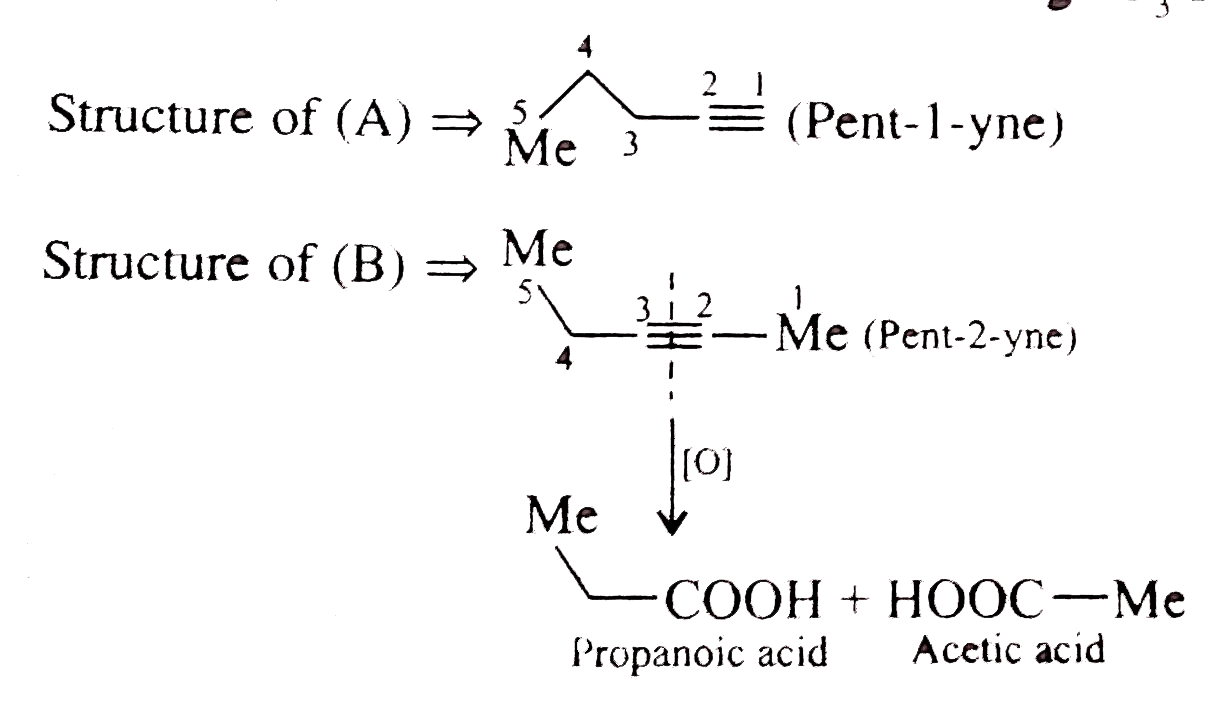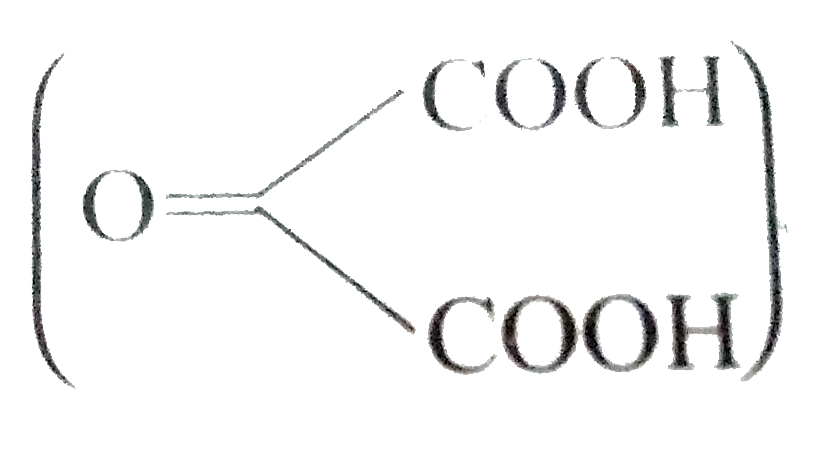Three compounds A, B, and C are isomers of the formula C5H8. All of them decolourise bromine in CCl4 and give a positive test with Baeyer's reagent. All three compounds dissolve in cone. H2SO4. Compound A gives a white precipitate with ammoniacal silver nitrate, whereas compounds B and C do not react with it. On hydrogenation, in the presence of platinum catalyst, both compounds A and B yield n-pentane, whereas compound C gives a product of formula C5H10. On oxidation with hot acidified KMnO4, B gave acetic acid and CH3CH2COOH. Identify compounds A, B, and C.
(C)−−−−−−−−−→[Ag(NH3)2]⊕ White ppt. (Terminal alkyne)
(A) and (B)H2+Pt−−−−→ 
(B)⇒ (Internal alkyne)
(Does not react with ammonium AgNO3 solution.)

Topper's Solved these Questions
- ALKYNESBOOK - CENGAGE CHEMISTRYCHAPTER - ALKYNESEXERCISE - Exercises (Linked Comprehension Type)
51 Videos
- ALKYNESBOOK - CENGAGE CHEMISTRYCHAPTER - ALKYNESEXERCISE - Exercises (Multiple Correct Answers Type)
25 Videos
- ALKYNESBOOK - CENGAGE CHEMISTRYCHAPTER - ALKYNESEXERCISE - Solved Examples
24 Videos
- ALKENES AND ALKADIENESBOOK - CENGAGE CHEMISTRYCHAPTER - ALKENES AND ALKADIENESEXERCISE - Single correct Answer
14 Videos
- APPENDIX - INORGANIC VOLUME 1BOOK - CENGAGE CHEMISTRYCHAPTER - APPENDIX - INORGANIC VOLUME 1EXERCISE - chapter-7 Single correct answer
1 Video
Similar Questions
Three compounds A,B and C all have molecular formula C6H8 All the compound rapidly decolourise Br2 in CCl4. All three give a position test with Baeyer's reagent. And all the three are soluble in cold conc. H2SO4. Compound A gives a precipitate when treated with ammonical AgNO3 solution. but compounds B and C do not compounds A and B both yield pentane (C5H12) when they are treated with excess H2 in the presence of Pt catalyst. Under these conditions, compound C absorbs only one mole of H2 and gives a product with the formula C5H10
View SolutionA compound 'A' when reacts with LiAlH4 it gives two compounds B and C along with LiCl. Compounds A, B and C respectively are
View Solution
Knowledge Check
Compound (A) C5H10O forms a phenyl hydrogen and gives negative Tollen's and iodoform tests. Compound (A) on reduction gives n-pentane. The compound (A) is
ACH3CH2CH2CH2O∣∣C−HBCH3CH2CH2O∣∣CCH3CCH3CH2O∣∣C−CH2CH3DCH3CH2CH2CH2CH2OH\Compound (A) C5H10O forms a phenyl hydrazone and gives negative Tollen's and iodoform tests. Compound (A) on reduction gives n-pentane. Compound (A) is :
ACH3CH2CH2CH2−O∣∣C−HBCH3CH2CH2−O∣∣C−CH3CCH3CH2−O∣∣C−CH2CH3DCH3CH2CH2CH2CH2−OHA compound with molecular formula, C4H8O gives a positive haloform test and a 2, 4-DNP derivative. The compound is
ACH3CH2CH2CHOBCH3COCH2CH3C(CH3)2CHCHODAll the above
a) Compound (A) C8H12 on oxidation gives an acid (B) C4H6O2. One molecule of compound (A) reacts with 3 mole of H2 in presence of platinum catalyst to give octane. Identify compound (A).

View SolutionWith alcoholic potash, C4H8Cl2 (A) gives C4H6 (B), which reacts with ammoniacal cuprous chloride. Identify the compounds (A) and (B).
View SolutionCompound 'A' when dissolved in water gives compound 'B'which is used in whitewashing.
Compound 'B' reacts with CO2 to form a white precipitate of compound 'C'. Identify compounds 'A', 'B' and 'C'. Also write the equations involved.
View SolutionA compound A with molecular formula C H Cl gives a white precipitate on adding silver nitrate solution. A on reacting with alcoholic KOH gives compound B as the main product. B on ozonolysis gives C and D.C gives Cannizaro reaction but not aldol condensation. D gives aldol condensation but not Cannizaro reaction. A is :
View SolutionA compound A with molecular formula C10H13Cl give a white precipitate on adding silver nitrate solution. A on reacting with alcoholic KOH gives compound B as the main product, B on ozonolysis gives C and D. C gives cannizaro reaction but not aldol condensation D gives aldol condensation but not Cannizaro reaction A is
View Solution
